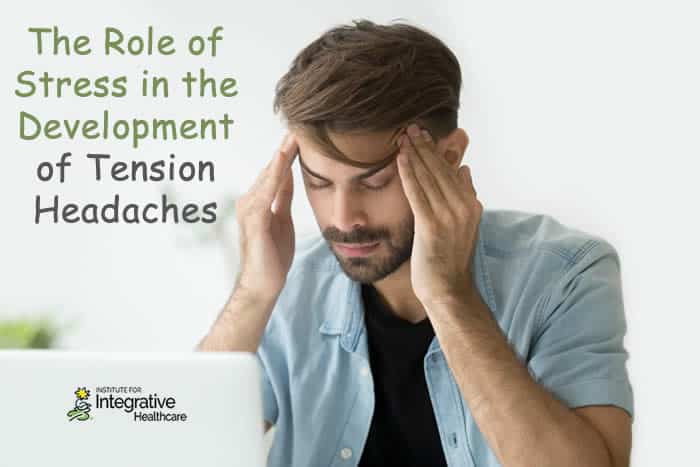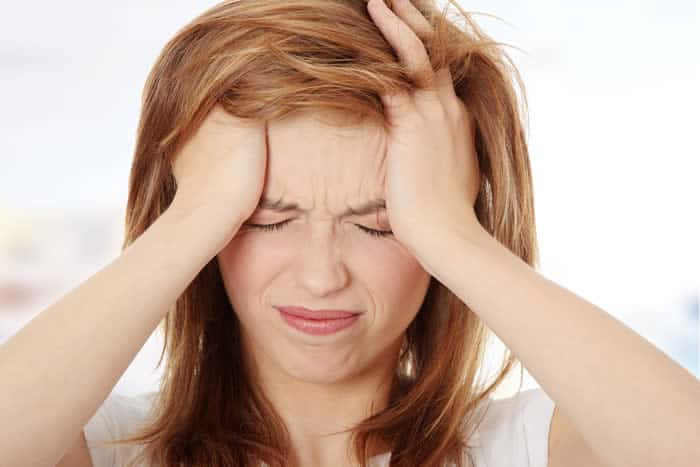April is Stress Awareness Month. Discover what a tension headache is, the role stress plays in developing this type of headache, and how massage therapy can help relieve them.

Clinically, tension headaches result from tightness in muscles within the neck, scalp and shoulder girdle regions. The tension created by this tight musculature results in a lack of blood flow to the cranium.
Tension headaches are characterized as either Episodic or Chronic.
- Episodic TTH (Tension-Type Headaches) occur infrequently, less than half of days in a month, and are reported by over 70% of the adult population.
- Chronic TTH occur more than half of days within a month and are reported by 1-3% of adults. (1)
BMJ Best Practice online provides further clarity in describing tension (tension-like) headaches:
- Stress and mental tension are common triggers.
- Common symptoms include dull, non-pulsatile (no pulsing felt) with pain felt bilaterally and non-severe constricting pain.
- There are no migraine sensations experienced.
- Remedies which alleviate muscle tension can alleviate tension headaches. These include physiotherapy, biofeedback and relaxation techniques. (2)
Tension type headaches affect millions of Americans annually. Many research studies have been conducted to determine how prevalent these headaches are witnessed in society. Baltimore County, Maryland studied over 13,000 individuals from their local community and determined prevalence of headaches, both episodic and chronic, peaked within the 30-39 year age range (42.3% in men, 46.9% in women). (3)
Some people also report irritability, fatigue, mood changes and depression if tension type headaches are consistently experienced. The mental toll headaches can take upon a person can become significant. The constant and frequent nature of headaches can feel burdensome and never-ending.
Massage Therapy for Tension-Type Headaches
Massage therapy can be a welcome part of a treatment plan to alleviate the physical and metaphysical manifestations of TTH.
Because TTH are caused by tight muscles within the neck, scalp and shoulder girdle muscles, the causes of these headaches pertain to what creates tension in these body regions. Amongst the many causes of muscle tension, alignment of the head and neck stand out. Forward head posture is a likely contributor for many people. This condition occurs when the head and neck are misaligned along the lateral line of alignment (ear to shoulder in lateral view).
Clinically, forward head posture increases tension placed upon the muscles, bones, ligaments and tendons of the head and neck region. This contributes to pain, headaches and dysfunction of local anatomical joints and structures. The increased tension will make muscles tighten – thus contributing to tension-type headaches. (4)
Muscles That Increase Tension
Muscles which will increase tension load and become hypertonic will include all the muscles that support the weight of the head and neck:
- Scalenes
- Sternocleidomastoid
- Longus Colli & Capitis
- Trapezius
- Splenius Capitis & Cervicis
- Levator Scapulae
- and upper Erector Spinae
When these muscles become tense, nerve compressions and congestion of blood flow can occur, thus contributing to the headache sensations experienced with TTH.
Stress and Tension Type Headaches

As mentioned earlier, stress plays a vital role in the development of tension type headaches. Psychology Today defines stress in two manners:
- a psychological perception of pressure and
- the body’s response to a stressor, involving multiple anatomical systems. (5)
Any event which pulls one’s body out of homeostasis can be defined as a stressor. Identifying stressors can be an important first step in facilitating a treatment plan to alleviate tension type headaches. Once identified, a game plan can be created to curtail the impact of each stressor.
Stress can have many negative impacts within the body. The Mayo Clinic informs patients that stress has many common effects.
- Upon the Body: Headaches, muscle tension or pain, chest pain, fatigue, change in sex drive, upset stomach, problems with sleeping.
- Upon one’s Mood: Anxiety, restlessness, lack of motivation or focus, feeling overwhelmed, irritability or anger, sadness, depression.
- Upon one’s Behavior: Overeating or undereating, angry outbursts, tobacco or other substance use, social withdrawing, exercising less often. (6)
Knowing the negative impacts of stress, a massage therapist can inquire if any of these impacts are presently affecting a client. When conducting a client intake, a massage therapist needs to take additional time to ask questions on the nature of stressors. Identifying stressors and how (or if) clients employ self-care means to combat stressors is great for a massage therapist to ascertain when devising treatment plans to aid clients with TTH.
Bodywork Modalities for Tension Type Headaches
There are many massage and bodywork modalities that can aid the recovery of tension type headaches. While someone in the midst of a headache may not receive massage therapy in the moment, after the acute symptoms subside massage therapy can be a viable option to curtail future headache bouts.
Conclusion
Cranial sacral therapy, myofascial release, trigger point therapy, and strain – counterstrain can ease stress patterns contributing to tension type headaches. Coupled with stress management means, tension type headaches can be fully alleviated for clients. Tracking which means works for a client and encouraging more of these activities and bodywork will be how a massage therapist can best support TTH clients.
References
- “Headache Disorders”, Staff, World Health Organization, www.who.int/news-room/fact-sheets/detail/headache-disorders,
- “Tension-Type Headache”, Staff, BMJ Best Practice, www.bestpractice.bmj.com/topics/en-gb/12, updated February 2021.
- “Epidemiology of Tension-Type Headache”, Schwarz, B, et al, National Library of Medicine, https://pubmed.ncbi.nlm.nih.gov/9459472/
- “Forward Head Posture”, Staff, Physiopedia, www.physio-pedia.com/Forward_Head_Posture
- “Stress”, Staff, Psychology Today, www.physiologytoday.com/us/basics/stress
- “Stress Management”, Mayo Clinic Staff, Mayo Clinic, www.mayoclinic.org/healthy-lifestyles/stress-management
- https://www.integrativehealthcare.org/mt/the-role-of-stress-in-the-development-of-tension-headaches/?utm_source=ActiveCampaign&utm_medium=email&utm_content=Stress%2C+Massage+++Tension+Type+Headaches&utm_campaign=MPU259
About the Author

Jimmy Gialelis, LMT, is a national board certified clinical practitioner passionate about clients actualizing maximum health gains. A member of the Massage Therapy Hall of Fame, he contributes to the Massage & Bodywork Licensure Exam as an exam item writer. He maintains a continuing education business, Advanced Massage Arts & Education, along with his private practice studio in Tempe, AZ.







